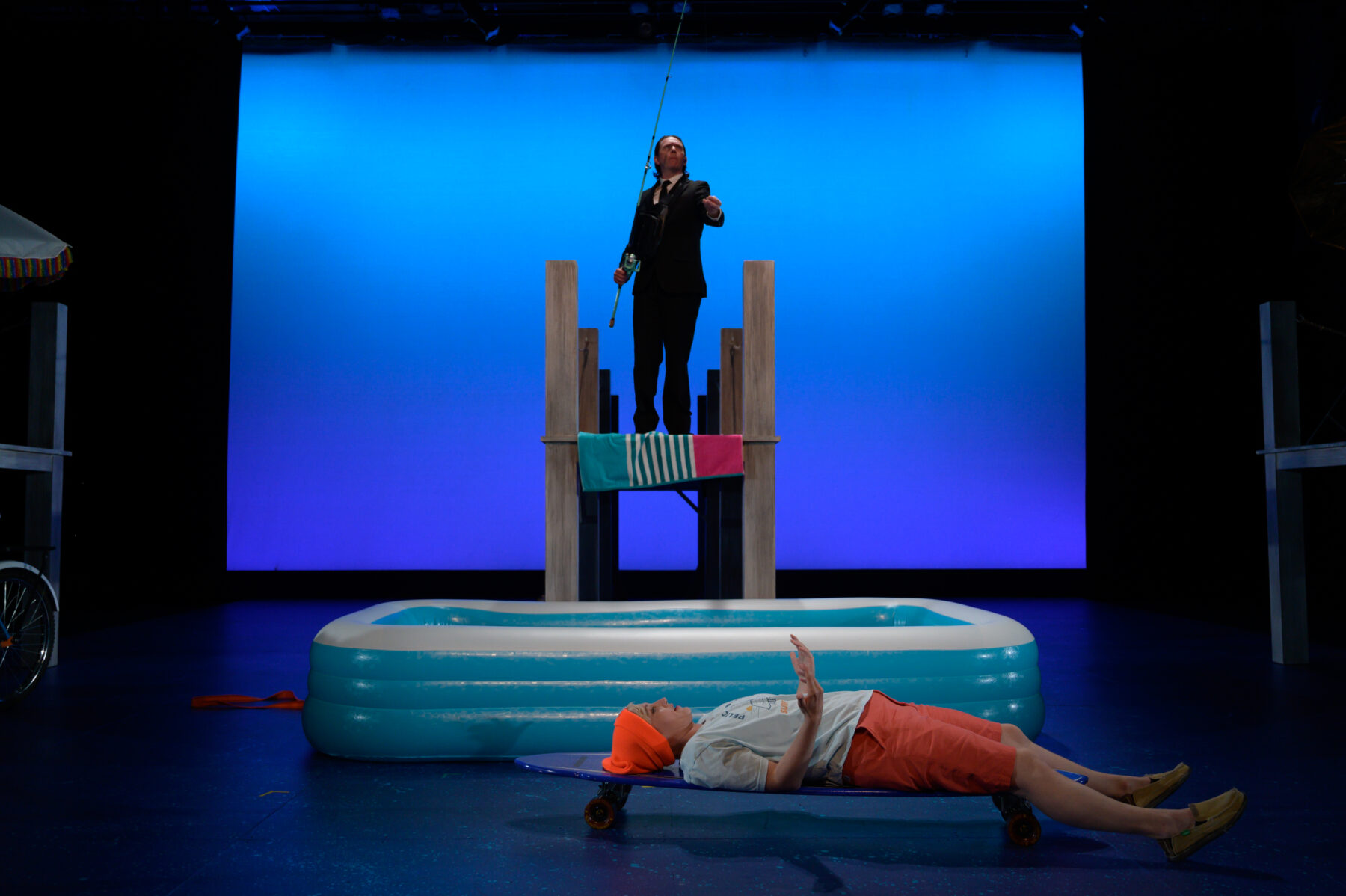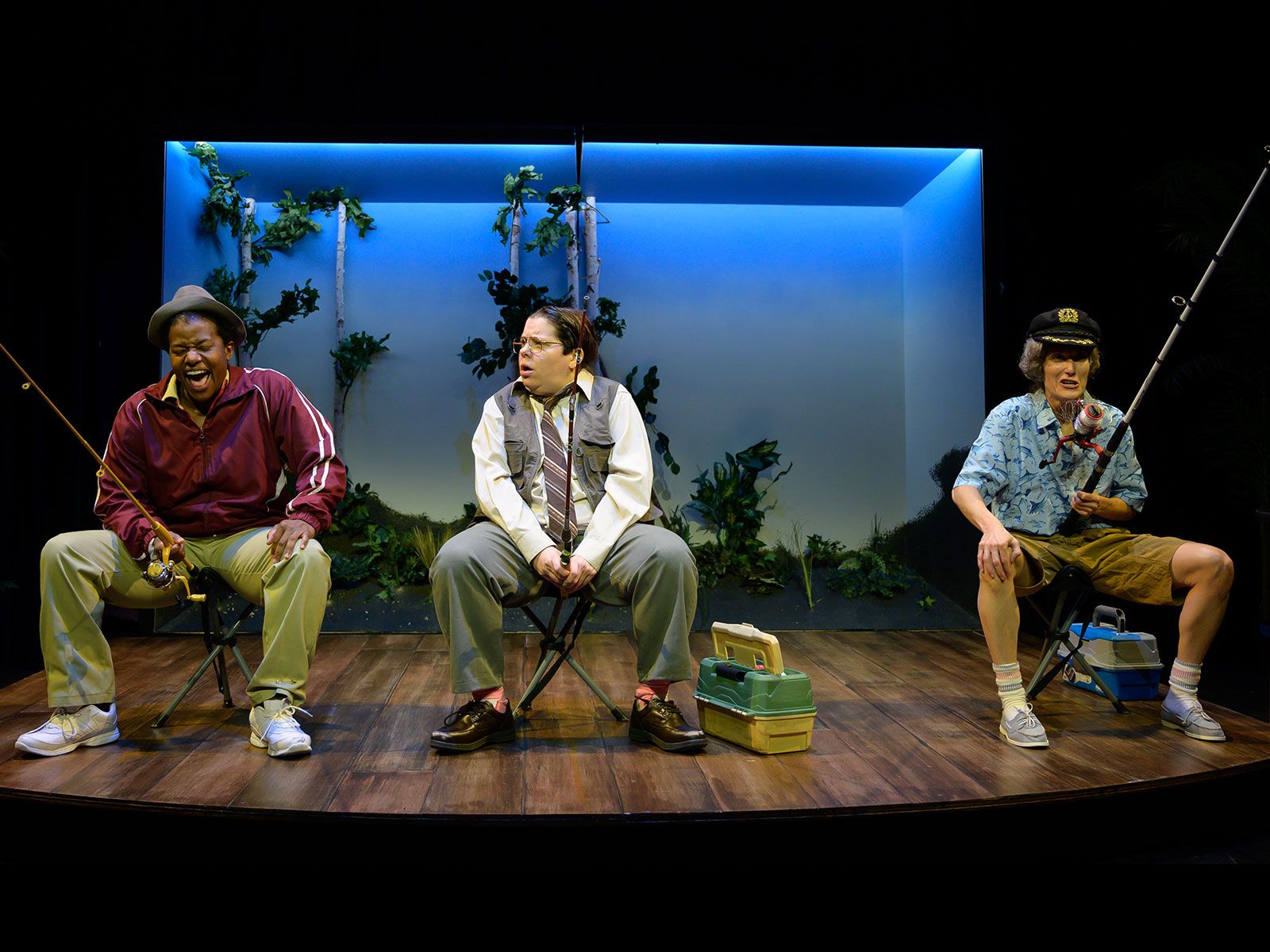November 2, 2023
by Kinohi Nishikawa – Wilma Board Member
The Wilma Theater’s 2022-2023 season ended with Twelfth Night, and like many theatergoers, this wasn’t my first encounter with Shakespeare’s play. I’ve read Twelfth Night a handful of times, I’ve seen different versions of it over the years, and I even had the role of Malvolio thrust upon me in college. OK, sure, I had auditioned for the part. But it was only after several weeks of rehearsal that I realized how difficult it is to make dramatic sense of his character. A steward at once bullying and besotted, sneering and sneered at—the wet blanket thrown over the fun to be had in Illyria. I can’t say I pulled off a convincing Malvolio, but ever since I played him, I’ve sought out Twelfth Night to help me understand his character.
The Wilma’s production matched my preexisting interest. Keith J. Conallen’s Malvolio was delightfully self-aggrandizing, his pomposity so overweening that even an endless summer at the Jersey Shore (as Misha Kachman’s eye-popping set evoked) couldn’t loosen him up. That took a turn, however, when Malvolio was tricked into believing that Viola (MK Tuomanen) has a thing for him. Taking the bait, Malvolio attempted to strut his way into her heart, regaled in yellow stockings and cross garters. Seeing his ardor misplaced, the clowns Andrew Aguecheek (Jered McLenigan) and Toby Belch (Lindsay Smiling) ensnared the steward in a devious plan to make him look mad. His comeuppance was madcap and righteous. Yet it was also a wee bit mean-spirited. At this point, the audience didn’t quite sympathize with Malvolio, but neither did it condone the relentless gulling of him by others. Director Yury Urnov added a note of disquiet to Malvolio’s comic undoing by visually referencing scenes from Stanley Kubrick’s A Clockwork Orange. The steward’s wailing let the audience know that not everything done in good fun is innocent.

I don’t recall my Malvolio’s comeuppance being quite so pointed. Yes, the character has to be shown up as a stick in the mud. But my performance felt more like a kick up the backside than anything that courted meanness. That’s been true of other Malvolios I’ve seen. And this is why the Wilma production surprised me. Urnov bravely embraced the question of how far to take Malvolio’s fall as a question that’s central, not peripheral, to the drama of Twelfth Night. In the production, with Malvolio nearly broken by the double-cross, the other characters paired up, resolved their misperceptions, and vowed to play on. The matchings relieved the tension in the room, yet there hung in the air that note of disquiet left by Malvolio’s wails.
But then… then a humbled Malvolio ambled on stage, apart from the revelers. He took his seat on the dock next to Andrew, who amidst all the coupling, found himself the odd man out. Now the two men dangled their legs over the edge, wondering what to do next. In a moment of surprising tenderness, Andrew offered a rod to Malvolio, and both characters ended up fishing together. The moment was small, and it didn’t command the attention (rightfully so) like the gender-bending reveal of Twelfth Night’s conclusion. But for someone who’s played Malvolio, and who understands the difficulty of his character in the Shakespeare repertoire, the moment made all the difference to me. It wasn’t a scene of redemption, nor was it one of forgiveness. It amounted to a flicker of recognition, followed up by the relief, or catharsis, that one isn’t ever truly alone in this world. With the rest of the characters celebrating their unions, Malvolio and Andrew made for a happy-enough couple as the curtains closed.
As personally satisfying as that final moment was for me, it was made more profound because of a connection I drew between this performance and one I had seen at the Wilma all the way back in October, when the season began. I remembered another scene of two men fishing in the world premiere of Those with 2 Clocks. This rollicking production was part manifesto, part variety show, part cabaret, all aimed at skewering everyday forms of patriarchy and male privilege. Experiencing the work, which was brought to life by its creators Jess Conda, Jenn Kidwell, and Mel Krodman, was as provoking and uproarious as it must have been to see George C. Wolfe’s The Colored Museum when it debuted in 1986. Those with 2 Clocks had the collective spark of #MeToo, but it went far beyond the callouts of that movement by putting the actors’ bodies on the line, highlighting exactly what’s at stake in reckoning with the legacies of patriarchy.
The work was at turns crass and ironic, zany and reflective. As an audience member, you learned how to roll with its punches. Then, about an hour in, Those with 2 Clocks surprisingly, unexpectedly, took an extended pause. Against the backdrop of sun-dappled, wooded bliss, two male characters played by Conda and Kidwell cast their lines to fish. With the theater falling to a hush, the men waited… and waited… and waited… Minutes may have passed, but in comparison to the other sketches, this one made the audience feel like time had been dilated into an eternity. Beckett’s Waiting for Godot hovered over the scene, but given the setting, I was also reminded of Normal Maclean’s A River Runs through It. This was French existentialist absurdity and American call-of-nature masculinity rolled into one, with each form serving as the other side of the coin to the other.

Like Urnov and Conallen’s Malvolio, these characters weren’t bathed in a redemptive or salvific light. Edging right up to speaking, only to retreat to silence, the characters’ inability to express themselves was of a piece with the critique of masculinity in Those with 2 Clocks. But in this scene, that inability came across as endearing rather than evasive. For it was fishing, ultimately, that became the language that communicated all they had to say. The characters’ sinking into the routine of their hobby conveyed so much of their unspoken vulnerabilities, and Conda and Kidd embodied that softness, that quietness, to a tee. That little to nothing happened on stage was the point: the sheer duration of the scene allowed us to access the inner lives of these men who only know how to open up to each other through their reflections on the glassy surface of water.
The depth of this portrayal came back to me in a flash the moment I saw Malvolio and Andrew sit next to each other. My recognition was what the Wilma’s season had been preparing me for all along. Let me explain. As a season ticket subscriber, I have come to appreciate the Artistic Director’s role in curating an entire season of productions, with an eye toward drawing out the resonances between compelling, diverse fare. The idea, I’ve surmised, is not to standardize works that vary widely in conception, dialogue, staging, and characterization, to say nothing of cultural and geographical contexts. The idea, rather, is to let those natural differences come through in a commitment to an original vision, a Wilma vision, of what theater can do in any one performance and across a series of performances. That the fishing scene in Those with 2 Clocks stuck with me, only to have it referenced by the fishing scene in Twelfth Night months later, was made possible by performances that made me feel here, right here, utterly in the moment and thus able to receive what these two very different works might mean for me. Those meanings blend with different layers of memory and accrue over time. But without that initial, lasting impression, the performances would simply fade away.
Bookended by these fishing scenes, I begin to see how silence, vulnerability, loneliness, and a kind of middle-aged malaise form a through line of my experience of Artistic Director Morgan Green’s 2022-2023 season. I recall, for example, the final scene of Kiss, in which the falseness of melodramatic media culture was stripped bare to reveal the devastation of the Syrian civil war that is the setting for the play. I think about the anxieties expressed by different characters in Milo Cramer’s School Pictures, and how the audience talkbacks revealed community members’ recollections of their own unhappy school experiences. And, above all, I remember Nathan Alan Davis’s Eternal Life Part I, featuring a middle-aged dad (Steven Rishard) who must confront an uncertain future when his son (Brandon J. Pierce) goes off to college, leaving his parents empty nesters.
These are, no doubt, takeaways unique to me. But as I write this on the cusp of a new season debuting at the Wilma, I feel a certain closeness to these memories, precisely because they are mine and because they are indelible. In sharing them with you, my intention has not been to offer a review of last season or of one show. It’s been to share with you a way of experiencing the Wilma for everything it has to give audiences, a method of fusing individuals’ whole selves with the magic of live performance.

Kinohi Nishikawa specializes in 20th-century African American literature, book history, and popular culture. He earned his A.B. in English from Dartmouth College and his Ph.D. in literature from Duke University. At Princeton, Nishikawa teaches courses on African American humor, African American authors (James Baldwin), and Afro-Asian studies.
Nishikawa’s first book, Street Players: Black Pulp Fiction and the Making of a Literary Underground, was published by the University of Chicago Press in 2018. His major work in progress is “Black Paratext,” a study of how book design has influenced the production and reception of African American literature from World War II to the present. Nishikawa has published widely on modern African American print culture, with a particular emphasis on newspapers, magazines, and independent publishers.
Recent publications include an essay on black experimental novelist William Melvin Kelley in American Literary History (2018) and an article on Black Arts movement editor Hoyt W. Fuller in Chicago Review (2016). Nishikawa has also contributed chapters to the forthcoming collections Black Cultural Production after Civil Rights (Illinois), African American Expression in Print and Digital Culture (Wisconsin), and Are You Entertained? New Essays on Black Popular Culture in the Twenty-First Century (Duke).